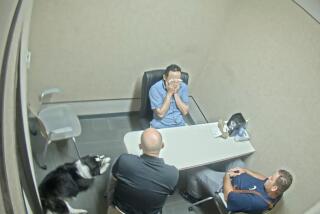Blood Found on Cara Knott’s Boot Matches Peyer’s Type, Experts Say
A small blood spot found on a boot worn by Cara Knott the night she died matches the blood type of former California Highway Patrol Officer Craig Peyer, two experts who conducted tests of the stain said Friday.
Testifying in Peyer’s retrial for the murder of Knott, serologist Gary Harmor said his calculations show that the donor of the blood on the white leather boot is among an estimated 12,800 people in San Diego County--or about 0.6% of the population.
Meanwhile, Peyer’s attorneys on Friday asked a state appellate court to reverse a ruling by Superior Court Judge Richard Huffman that barred key testimony from four witnesses called by the defense in Peyer’s first trial.
Court Order Sought
The petition asks the 4th District Court of Appeal to issue an order permitting testimony from witnesses who said they saw a scruffy hitchhiker acting strangely near a freeway on-ramp Knott probably used the night she was slain. The witnesses said the hitchhiker, who was never found but at first was considered a key suspect, lunged at cars and waved money in an apparent attempt to obtain a ride.
Last month, Huffman granted a request by prosecutors to prevent the so-called “hitchhiker testimony,” concluding that there was no evidence linking the man to Knott. But defense attorney Diane Campbell, in the 10-page petition filed Friday, argues that the defense should be allowed to present the witnesses “to rebut the elaborate inference” created by prosecutors that no one but Peyer could have committed the crime.
“The prosecution has painted a picture of a safe, deserted highway along which only Craig Peyer patroled, and that Ms. Knott could not have otherwise stopped her car,” Campbell wrote. “This is a false picture. . . . The jury will not be getting a true and accurate picture of the events of that night if it is allowed to hear only prosecution evidence on this issue.”
Quick Ruling Likely
Deputy Dist. Atty. Paul Pfingst is expected to conclude his part of the case Monday, and the Court of Appeal probably will rule quickly on the defense request.
Two other petitions also were filed with the appellate court by Campbell Friday, but their contents were sealed. Attorneys declined to comment on whether they concern a male juror who allegedly believes Peyer is innocent and lied to get on the jury.
A 13-year veteran of the CHP until he was fired last year, Peyer, 38, is accused of stopping Knott at the Mercy Road exit on Interstate 15, strangling her and throwing her body from an abandoned highway bridge. Knott’s body was found Dec. 28, 1986, in a dry creek bed. Her Volkswagen Beetle was parked nearby, with the keys in the ignition and the driver’s window partly rolled down.
In Favor of Conviction
On Feb. 25, jurors in Peyer’s first trial deadlocked 7 to 5 in favor of conviction. Jurors in the retrial may begin their deliberations by the end of next week.
Among Friday’s witnesses was Walter Fung, a Sheriff’s Department criminalist who analyzed the blood stain on Knott’s boot. Fung testified that the spot was Type A, the same type as Peyer’s blood.
Harmor, who works at the Serological Research Institute in the Bay Area, conducted a test that reveals genetic markers on blood and semen. The test uses “absorption inhibition” to identify antigens in blood that are called Gamma (Gm) and Kappa (Km) markers.
Similar to Peyer’s
The blood spot on Knott’s left boot, Harmor said, had Gm, Km and five other genetic markers similar to those on Peyer’s blood.
Harmor said he “surveyed” the victim’s blood-soaked sweat shirt for a trace that did not match her Type O blood. He said that, out of tests conducted on 54 spots on the shirt, one spot near the left shoulder seam of the garment matched Peyer’s Type A blood. That spot also had Gm, Km and several other genetic markers that characterize Peyer’s blood, he testified.
In his cross-examination of Harmor, defense attorney Robert Grimes attempted to raise doubts about how widely accepted the genetic marking test is. Harmor said the sophisticated test is practiced by about a dozen of an estimated 250 crime labs in the country.
20-Year Use in Europe
But Pfingst then asked whether many labs send blood samples to the few serologists trained to perform the test. Harmor said that was true. He further testified that the procedure has been in use in Europe for 20 years and is practiced in Canada and Japan as well.
Grimes also questioned Harmor about his statement that 12,800 people in the county, including Peyer, could have been donors of the blood found on Knott’s boot. Harmor said about half of those people are women and many are children and elderly. Grimes asked whether 12,800 was “about how much the Sports Arena holds when it’s full,” to which Harmor replied, “I don’t know.”
Earlier Friday, an Illinois fiber expert testified about a gold fiber found on Knott’s sweat shirt, a fiber that other experts have said matches the gold thread in the patches lifted from Peyer’s CHP jacket.
Fiber Distinctive
Richard Bisbing, who analyzes the amount of light that passes through the dye in fibers, testified that the rayon fiber is distinctive in that its dye contains yellow pigment particles added at the time it was manufactured.
“It’s quite unusual,” said Bisbing, who has been studying fibers for 18 years. “I’m sure it’s been done before but . . . I had never seen a fiber dyed in this way.”
Bisbing also testified that three purple fibers from sweat pants Knott was wearing the night she died match microscopic purple fibers lifted from Peyer’s service revolver and boot. Further, he said blue fibers taken from bags wrapped around Knott’s hands when her body was found match thread in the border area of the CHP patch on Peyer’s jacket.
Under cross-examination from Grimes, Bisbing said he could not say with certainty that any of the matching fibers came from the same source or were manufactured by the same factory.
More to Read
Sign up for Essential California
The most important California stories and recommendations in your inbox every morning.
You may occasionally receive promotional content from the Los Angeles Times.










